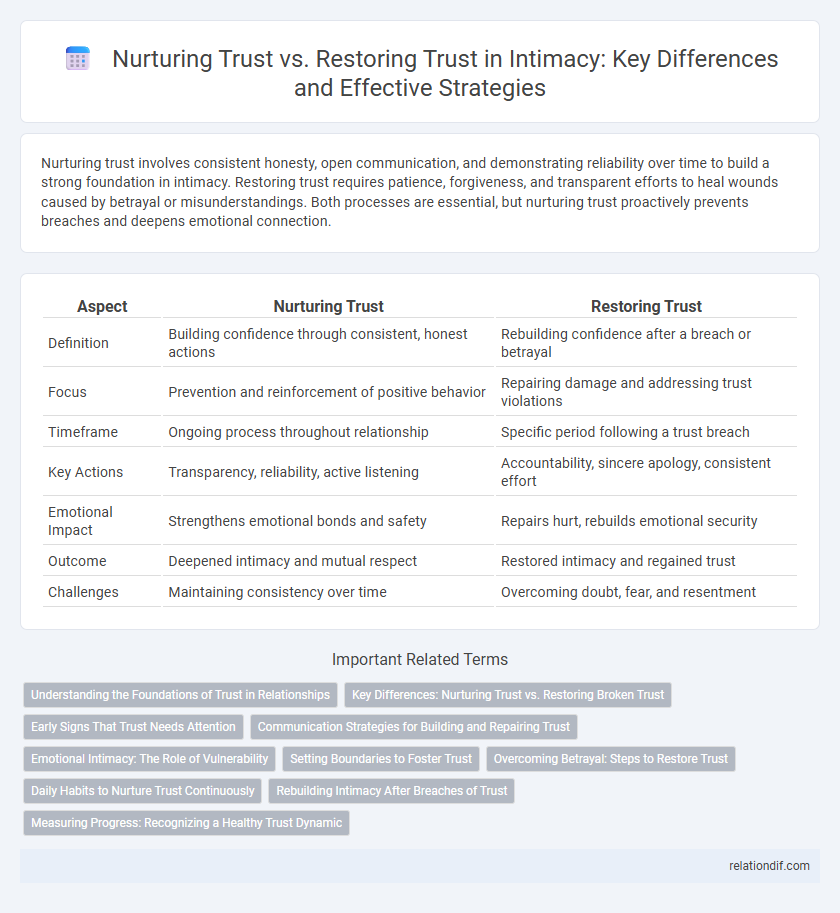Nurturing trust involves consistent honesty, open communication, and demonstrating reliability over time to build a strong foundation in intimacy. Restoring trust requires patience, forgiveness, and transparent efforts to heal wounds caused by betrayal or misunderstandings. Both processes are essential, but nurturing trust proactively prevents breaches and deepens emotional connection.
Table of Comparison
| Aspect | Nurturing Trust | Restoring Trust |
|---|---|---|
| Definition | Building confidence through consistent, honest actions | Rebuilding confidence after a breach or betrayal |
| Focus | Prevention and reinforcement of positive behavior | Repairing damage and addressing trust violations |
| Timeframe | Ongoing process throughout relationship | Specific period following a trust breach |
| Key Actions | Transparency, reliability, active listening | Accountability, sincere apology, consistent effort |
| Emotional Impact | Strengthens emotional bonds and safety | Repairs hurt, rebuilds emotional security |
| Outcome | Deepened intimacy and mutual respect | Restored intimacy and regained trust |
| Challenges | Maintaining consistency over time | Overcoming doubt, fear, and resentment |
Understanding the Foundations of Trust in Relationships
Nurturing trust involves consistent honesty, open communication, and emotional vulnerability that deepen connection over time. Restoring trust requires addressing breaches with accountability, empathy, and transparent actions to rebuild security and emotional safety. Understanding the foundations of trust in relationships highlights the importance of reliability, respect, and mutual support as essential pillars for lasting intimacy.
Key Differences: Nurturing Trust vs. Restoring Broken Trust
Nurturing trust involves consistent actions, open communication, and emotional transparency to build a strong foundation in relationships. Restoring broken trust requires acknowledging mistakes, offering genuine apologies, and demonstrating reliable behavior over time to rebuild lost confidence. The key difference lies in prevention through ongoing care versus repair through intentional efforts after trust is damaged.
Early Signs That Trust Needs Attention
Early signs that trust needs attention include frequent misunderstandings, reluctance to share feelings, and increased defensiveness during conversations. Noticing these patterns helps partners address issues before they escalate, nurturing trust through open communication and consistent reliability. Recognizing and responding promptly to these signals strengthens emotional bonds and prevents the need for extensive trust restoration later.
Communication Strategies for Building and Repairing Trust
Effective communication strategies for building and repairing trust emphasize consistent honesty, active listening, and empathy to create a safe emotional space. Nurturing trust involves transparent dialogue and regular affirmation of commitments, while restoring trust requires acknowledging breaches, expressing genuine remorse, and collaboratively setting clear expectations. Utilizing non-defensive communication and validating emotions fosters mutual understanding and strengthens relational intimacy.
Emotional Intimacy: The Role of Vulnerability
Emotional intimacy deepens through consistent vulnerability, allowing partners to nurture trust by sharing fears, hopes, and authentic feelings. Nurturing trust requires ongoing openness that fosters a safe environment where emotional risks feel supported and respected. Restoring trust after breaches demands re-establishing this vulnerability to rebuild the emotional connection that sustains intimacy.
Setting Boundaries to Foster Trust
Setting clear boundaries plays a crucial role in nurturing trust within intimate relationships by ensuring mutual respect and understanding. Consistently honoring these boundaries establishes a safe space where partners feel valued and secure, preventing misunderstandings and emotional breaches. When trust is compromised, reestablishing boundaries with open communication becomes essential for restoring confidence and rebuilding intimacy effectively.
Overcoming Betrayal: Steps to Restore Trust
Nurturing trust requires consistent transparency, open communication, and emotional vulnerability, which collectively strengthen intimacy over time. Overcoming betrayal involves deliberate steps such as acknowledging the breach, expressing genuine remorse, and committing to behavior change to rebuild the damaged bond. Restoring trust demands patience and empathy from both partners to heal emotional wounds and reestablish a secure connection.
Daily Habits to Nurture Trust Continuously
Establishing daily habits such as consistent communication, active listening, and expressing appreciation fosters an environment where trust naturally grows over time. Regularly checking in with your partner's feelings and maintaining transparency about intentions reinforce emotional safety. These ongoing practices cultivate a deep sense of security, making trust a sustained pillar of intimacy rather than a fragile element to repair.
Rebuilding Intimacy After Breaches of Trust
Rebuilding intimacy after breaches of trust requires consistent actions that demonstrate reliability and transparency to nurture trust over time. Prioritizing open communication and emotional vulnerability fosters a safe environment where both partners can heal and reconnect. Establishing new patterns of honesty and accountability is essential in restoring a sense of security and deepening emotional bonds.
Measuring Progress: Recognizing a Healthy Trust Dynamic
Measuring progress in nurturing trust involves observing consistent open communication, emotional safety, and mutual reliability within the relationship. A healthy trust dynamic is indicated by transparent vulnerability and a steady increase in shared experiences that reinforce confidence. Restoring trust requires identifying milestones such as repaired respect and regained predictability to track healing and rebuild intimacy.
nurturing trust vs restoring trust Infographic

 relationdif.com
relationdif.com